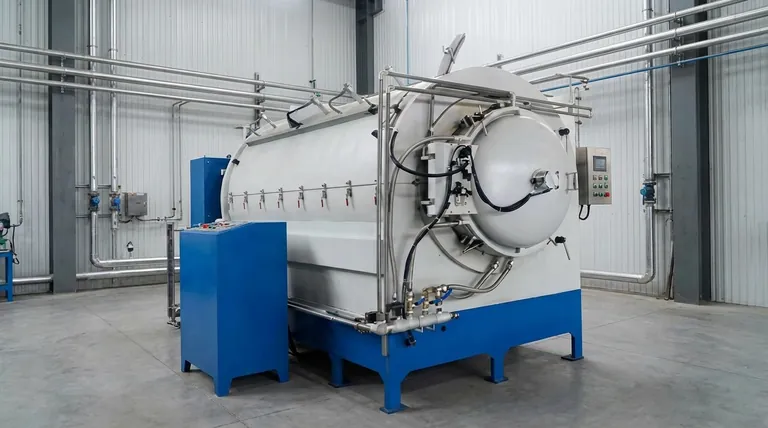The cost of a vacuum brazing furnace is not a single figure but a wide spectrum determined by its specific capabilities, size, and intended application. Because these furnaces are highly specialized pieces of industrial equipment, the price is directly tied to the technical requirements needed to achieve a successful, repeatable brazing process for a specific industry, such as aerospace or metallurgical research.
The final investment in a vacuum brazing furnace is a direct reflection of its technical specifications. Key cost drivers include the size of the hot zone, the maximum achievable temperature and vacuum level, the sophistication of its control systems, and the need for industry-specific certifications like NADCAP.

Key Factors That Determine Furnace Cost
Understanding the primary components and features that influence the final price is essential for making an informed investment. The cost is built upon layers of engineering designed to solve specific manufacturing challenges.
Hot Zone Size and Construction
The hot zone is the insulated, high-temperature core of the furnace where the brazing takes place. Its size is a primary cost driver.
A larger hot zone not only consumes more raw materials (like molybdenum or graphite) but also requires a more powerful heating and vacuum system to support its volume. This directly scales the overall cost of the furnace.
Temperature and Vacuum Performance
The operational limits of the furnace have a significant impact on price.
A furnace designed for higher temperatures requires more advanced, and therefore more expensive, heating elements and insulation. Similarly, achieving a deeper vacuum (a lower pressure) necessitates more powerful and complex pumping systems, which adds to the cost.
Control Systems and Automation
Modern furnaces are far more than simple ovens; they are precision instruments. The level of control and automation is a major factor in the final price.
Features like sophisticated cycle programming allow for extremely precise, multi-stage heating and cooling ramps. The ability to use barcode-linked programs, as mentioned in industry documentation, adds automation that ensures perfect repeatability but also increases the initial investment.
Industry-Specific Certifications
For many industries, compliance with rigorous standards is non-negotiable. This is a critical cost consideration.
Achieving certifications like NADCAP (National Aerospace and Defense Contractors Accreditation Program) requires superior design, high-grade materials, and advanced data logging and control systems. A furnace built to meet these requirements will carry a significant price premium over a standard industrial model.
Understanding the Trade-offs: Cost vs. Capability
Choosing a vacuum brazing furnace involves balancing the initial investment against long-term operational value and market opportunities.
Upfront Cost vs. Operational Efficiency
A furnace with advanced automation may have a higher purchase price, but it can reduce labor costs, minimize human error, and increase throughput over its lifetime. This trade-off between capital expenditure and operational expenditure is a key strategic decision.
Basic Functionality vs. Market Access
A lower-cost furnace may be perfectly suitable for general-purpose work. However, it may lack the temperature uniformity, vacuum performance, or data logging required for high-value sectors like aerospace or medical devices.
Investing in a certified furnace is often a prerequisite for entering these lucrative but demanding markets. The higher cost becomes an enabler for new business.
How to Approach Your Investment
To determine the right furnace for your needs, you must first define your primary objective.
- If your primary focus is research and development or small-scale prototyping: A smaller, more basic furnace with good temperature control may be the most cost-effective solution.
- If your primary focus is high-volume, repeatable production: Prioritize a furnace with robust automation, barcode integration, and a hot zone sized for your typical workload to maximize efficiency.
- If your primary focus is serving the aerospace, medical, or defense industries: Meeting NADCAP or similar requirements is non-negotiable; the investment must prioritize compliance, data integrity, and precision above all else.
Ultimately, the right vacuum brazing furnace is an investment in capability, and its cost is a direct function of the specific problems you need to solve.
Summary Table:
| Cost Factor | Impact on Price |
|---|---|
| Hot Zone Size | Larger size = higher material and system costs |
| Max Temperature & Vacuum | Higher performance = more advanced components |
| Control Systems & Automation | Advanced features increase precision and price |
| Industry Certifications (e.g., NADCAP) | Compliance adds significant premium |
Ready to invest in a vacuum brazing furnace tailored to your needs? At KINTEK, we specialize in high-performance lab equipment and consumables designed for precision and reliability. Whether you're in R&D, high-volume production, or serving demanding industries like aerospace, our solutions ensure optimal results. Contact us today to discuss your requirements and discover how KINTEK can enhance your laboratory capabilities!
Visual Guide

Related Products
- Vacuum Heat Treat Sintering Brazing Furnace
- Vacuum Heat Treat Furnace with Ceramic Fiber Liner
- Vacuum Heat Treat Furnace and Levitation Induction Melting Furnace
- Molybdenum Vacuum Heat Treat Furnace
- 2200 ℃ Tungsten Vacuum Heat Treat and Sintering Furnace
People Also Ask
- What is brazing in heat treatment? Achieve Superior Joint Quality and Efficiency
- What are vacuum furnaces used for? Unlock Ultimate Material Purity and Performance
- What is a vacuum furnace used for? Unlock Purity in High-Temperature Processing
- Can dissimilar metals be brazed or braze welded? A Guide to Strong, Reliable Joints
- What is the process of a vacuum furnace? Achieve Purity and Precision in High-Temp Processing



















